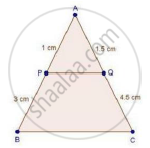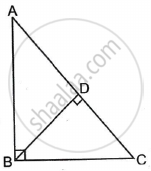Advertisements
Advertisements
Question
ABC is a triangle and PQ is a straight line meeting AB in P and AC in Q. If AP = 1 cm, PB = 3 cm, AQ = 1.5 cm, QC = 4.5 m, prove that area of ΔAPQ is one- sixteenth of the area of ABC.
Solution

We have,
AP = 1 cm, PB = 3 cm, AQ = 1.5 cm and QC = 4.5 m
In ΔAPQ and ΔABC
∠A = ∠A [Common]
`"AP"/"AB"="AQ"/"AC"` [Each equal to 1/4]
Then, ΔAPQ ~ ΔABC [By SAS similarity]
By area of similar triangle theorem
`("area"(triangleAPQ))/("area"(triangleABC))=1^2/4^2`
`rArr("area"(triangleAPQ))/("area"(triangleABC))=1^2/16xx"area"(triangleABC)`
APPEARS IN
RELATED QUESTIONS
Prove that the area of the triangle BCE described on one side BC of a square ABCD as base is one half the area of the similar Triangle ACF described on the diagonal AC as base
D and E are points on the sides AB and AC respectively of a ∆ABC such that DE || BC and divides ∆ABC into two parts, equal in area. Find
Two isosceles triangles have equal vertical angles and their areas are in the ratio 16 : 25. Find the ratio of their corresponding heights
D, E and F are respectively the mid-points of sides AB, BC and CA of ΔABC. Find the ratio of the area of ΔDEF and ΔABC.
In ΔABC, D and E are the mid-points of AB and AC respectively. Find the ratio of the areas of ΔADE and ΔABC
ABCD is a trapezium in which AB || CD. The diagonals AC and BD intersect at O. Prove that: (i) ΔAOB and ΔCOD (ii) If OA = 6 cm, OC = 8 cm,
Find:(a) `("area"(triangleAOB))/("area"(triangleCOD))`
(b) `("area"(triangleAOD))/("area"(triangleCOD))`
If ΔABC and ΔBDE are equilateral triangles, where D is the mid-point of BC, find the ratio of areas of ΔABC and ΔBDE.
ABC is a right triangle in which ∠B = 90°. If AB = 8 cm and BC = 6 cm, find the diameter of the circle inscribed in the triangle.
In the adjoining figure, ΔADB ∼ ΔBDC. Prove that BD2 = AD × DC.

Find the length of ST, if ΔPQR ∼ ΔPST.

